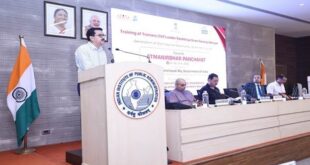- Recently, the Union Government set up a committee headed by the former Union Agricultural secretary to further look into the issues of Minimum Support Price (MSP) and Natural Farming.
- What was the Purpose of forming the Committee?
- It has been constituted as a follow-up to an announcement by Prime Minister when he had declared the government’s intention to withdraw the three farm laws.
- The protesting farmers had demanded a legal guarantee on MSP, based on Swaminathan Commission’s ‘C2+50% formula’.
- The Swaminathan Commission Report states that the government should raise the MSP to at least 50% more than the weighted average cost of production. It is also known as the C2+ 50% formula.
- It includes the imputed cost of capital and the rent on the land (called ‘C2’) to give farmers 50% returns.
- This was in addition to their demand for repeal of the three farm laws — Farmers Produce Trade and Commerce (Promotion and Facilitation) Act, 2020; Farmers (Empowerment and Protection) Agreement on Price Assurance and Farm Services Act, 2020; and the Essential Commodities (Amendment) Act, 2020.
Role of the Committee
- It would discuss approaches to develop the Agricultural Marketing System in accordance with the changing needs of the country in order to ensure higher value to farmers through remunerative prices for their produce by leveraging domestic output and export.
- To give suggestions to make available MSP to farmers of the country by making the system more effective and transparent.
- To give suggestions on practicality to give more autonomy to Commission for Agricultural Costs and Prices (CACP) and measures to make it more scientific.
Natural Farming:
- It would give suggestions for programmes and schemes for value chain development, protocol validation, and research for future needs,
- Also, push support for area expansion under the Indian Natural Farming System through publicity and through involvement and contribution of farmer organisations.
Crop diversification:
- It will investigate, and map present cropping patterns of agro-ecological zones in producer and consumer states.
- Promote a diversification policy approach to varying the cropping pattern according to the changing needs of the country.
MSP
- Minimum Support Price (MSP) is a form of market intervention by the Government of India to insure agricultural producers against any sharp fall in farm prices.
- The minimum support prices are announced by the Government of India at the beginning of the sowing season for certain crops on the basis of the recommendations of the Commission for Agricultural Costs and Prices (CACP).
Presently, the government announces minimum support prices for 23 crops.
Crops covered by MSPs include:
- 7 types of cereals (paddy, wheat, maize, bajra, jowar, ragi and barley),
- 5 types of pulses (chana, arhar/tur, urad, moong and masur),
- 7 oilseeds (rapeseed-mustard, groundnut, soyabean, sunflower, sesamum, safflower, nigerseed),
- 4 commercial crops (cotton, sugarcane, copra, raw jute).
Objectives:
- MSP is a price fixed by the Government of India to protect the producer – farmers – against excessive falls in price during bumper production years.
- The major objectives are to support the farmers from distress sales and to procure food grains for public distribution.
- In case the market price for the commodity falls below the announced minimum price due to bumper production and glut in the market, government agencies purchase the entire quantity offered by the farmers at the announced minimum price.
Factors Considered for Fixing MSP:
- The demand and supply of a commodity
- Its cost of production
- The market price trends (both domestic and international)
- Inter-crop price parity
- The terms of trade between agriculture and non-agriculture (that is, the ratio of prices of farm inputs and farm outputs)
- A minimum of 50% as the margin over the cost of production
- The likely implications of an MSP on consumers of that product
SOURCE: THE HINDU,THE ECONOMIC TIMES,MINT
 Chinmaya IAS Academy – Current Affairs Chinmaya IAS Academy – Current Affairs
Chinmaya IAS Academy – Current Affairs Chinmaya IAS Academy – Current Affairs



